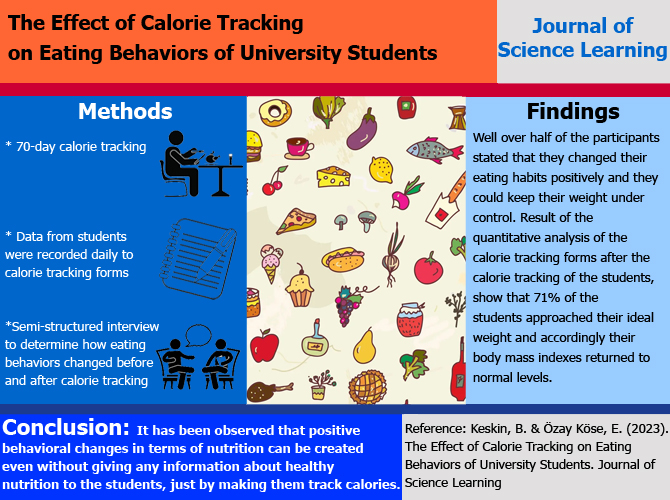
The Effect of Calorie Tracking on Eating Behaviors of University Students
Abstract
Full Text:
Download PDFReferences
Baban, A. (2010, April). Counseling for health promation. 9.Uluslararası Katılımlı Ulusal Hemşirelik Öğrencileri Kongresi. Muğla, Türkiye.
Baş, M., Aşçı, F.H., Karabudak, E., & Kızıltan, G. (2005). Eating attitudes and their psychological correlates among Turkish adolescents. Adolescence, 39, 593-599.
Bawazeer N. M, Alwagait E. F, Alzanan R. I, Almustafa D. Z, Aladalah G. A, Alsubhi F. A, Almutairi S. A, Benajiba N. (2021). Association between Menus’ Calorie Labels and Students’ Food Choices: A Cross-sectional Study. Current Research In Nutrition and Food Science, 10(2), 777-789. http://dx.doi.org/10.12944/CRNFSJ.10.2.30
Baysal A., & Bas M. (2008). Yetiskinlerde Ağırlık Yönetimi. İstanbul, Türkiye: Ekspress Baskı A.S.
Burke, L. E., Styn, M. A., Sereika, S. M., Conroy, M. B., Ye, L., Glanz, K., Sevick, M.A., & Ewing, L. J. (2012). Using mHealth technology to enhance self-monitoring for weight loss: a randomized trial. American Journal of Preventive Medicine, 43(1), 20–26. https://doi.org/10.1016/j.amepre.2012.03.016
Chua, J. E.,Zaldua, J. A., Sevilla, T. J., Tapel, M. J., Orlino, M. R., Rasing, D. C.,& Lee-Ramos, C.M. (2014). An android phone application for a health monitoring system with integrated medical devices and localized health information and database for healthy lifestyle changes. 7th IEEE International Conference Humanoid, Nanotechnology, Information Technology Communicationand Control, Environment and Management (HNICEM) TheInstitute of Electricaland Electronics Engineers Inc. (IEEE) – PhilippineSection, Philippines, 1-6.
Cohn, L.D., Macfarlane, S., Yanez, C., & Imai, W.K. (1995). Riskperception: differences between adolescents and adults. Health Psychology, 14(3), 217-222.
Direito A, Walsh D, Hinbarji M, Albatal, R., Tooley, M., Whittaker, R., & Maddison, R. (2018). Using the Intervention Mapping and Behavioral Intervention Technology Frameworks: Development of an mHealth Intervention for Physical Activity and Sedentary Behavior Change. Health Education & Behavior 45(3), 331-348. https://doi.org/10.1177/1090198117742438
Döner Güner, P. , Bölükbaşı, H. , Kokaçya, S.H. , Yengil, E. & Özer, C. (2018). Mustafa Kemal University Students' Use of Mobile Health Applications. Konuralp Medical Journal, 10(3), 264-268. https://doi.org/10.18521/ktd.426863
Ernsting, C., Dombrowski, S.U., Oedekoven, M., Kanzler, M., Kuhlmey, A., & Gellert, P. (2017). Using smartphones and health apps to change and manage health behaviors: a population-based survey. Journal of Medical Internet Research, 19(4), 1–12. https://doi.org/10.2196/jmir.6838
Giridher, T., Wasilewska, A., Wong, J.L. & Rekhi, K.S. (2010). Global mobile applications for monitoring health. Proceedings of the International Multiconference on Computer Science and Information Technology, 5, 855-859.
Güler E. (2015). Mobil sağlık hizmetlerinde oyunlaştırma. Açıköğretim Uygulamaları ve Araştırmaları Dergisi, 1(2), 82-101.
Jahns, R. G. (2013). The market for mHealth app services will reach $26 billion by 2017. Res Rep. Available: http://www. research2guidance. com/the-market-formhealth-app-services-will-reach-26-billion-by-2017/. Accessed, 27..
Kim, J., Park, S.K., & Lim, Y.J. (2007). Analysis of the Factors Affecting the Success of Weight Reduction Programs. Yonsei Medical Journal, 48(1), 24-29. https://doi.org/10.3349/ymj.2007.48.1.24
Kopmaz, B., & Arslanoğlu, A. (2018). Mobil Sağlık ve Akıllı Sağlık Uygulamaları. Sağlık Akademisyenleri Dergisi, 5(4), 251-255. https://doi.org/10.5455/sad.13-1543239549
Krebs P., & Duncan D.T. (2015). Health App Use Among US Mobile Phone Owners: A National Survey. JMIR mHealth and uHealth. 3(4), 1–12. https://doi.org/10.2196/mhealth.4924
Kumar, S., Nilsen, W.J., Abernethy, A., Atienza, A., Patrick, K., Pavel, M., Riley, W.T., Shar, A., Spring, B., Spruijt-Metz, D., Hedeker, D. Honavar, V., Kravitz, R., Craig Lefebvre, R., Mohr, D.C., Murphy, S.A., Quinn, C., Shusterman, V., & Swendeman, D. (2013). Mobile Health Technology Evaluation: The mHealth Evidence Workshop. American Journal of Preventive Medicine. 45(2), 228–236. https://doi.org/10.1016/j.amepre.2013.03.017
Mercan, Y., Dizlek, K., Süsim, G., Gürez, D. & Akman, Y. (2020). Sağlık Amaçlı İnternet Kullanımı ve Mobil Sağlık Uygulamaları Üzerine Bir Araştırma. Kırklareli Üniversitesi Sosyal Bilimler Meslek Yüksekokulu Dergisi, 1(1), 66-76.
Oran, N. T, Toz, H., Küçük, T., & Uçar, V. (2017). Medyanın Kadınların Beslenme Alışkanlıkları, Besin Seçimi ve Tüketimi Üzerindeki Etkileri. Life Sciences, 12(1), 1-13. https://www.doi.org/10.12739/NWSA.2017.12.1.4B0008
Özdoğan, Y., Yardımcı, H., & Özçelik, A.Ö. (2012). Yurtta Kalan Üniversite Öğrencilerinin Beslenme Alışkanlıkları. Karadeniz Uluslararası Bilimsel Dergi, 1(15), 139-149.
Pavlidou, E., Papadopoulou, S. K., Seroglou, K., & Giaginis, C. (2023). Revised harris–benedict equation: new human resting metabolic rate equation. Metabolites, 13(2), 189.
Pelletier, J.E., Graham, D.J., & Laska, M.N. (2014). Social norms and dietary behaviors among young adults. American Journal of Health Behavior, 38(1), 144-152. https://doi.org/10.5993/AJHB.38.1.15
Polat, A., Yücel, B., Genç, A., & Meteris, H. (2005). Bir Grup Üniversite Öğrencisinde Yeme Davranışı Özellikleri: Bir Ön Çalışma. Nöropsikiyatri Arşivi, 42(1-2-3-4), 5-8.
Pope, C., Halford, S., Turnbull, J., & Prichard, J. (2014). Cyborg practices: Call-handlers and computerised decision support systems in urgent and emergency care. Health Informatics Journal, 20(2), 118–126. https://doi.org/10.1177/1460458213486470
Raby Powers, A., Struempler, B.J., Guarino, A. & Parmer, S.M. (2005), Effects of a nutrition education program on the dietary behavior and nutrition knowledge of second-grade and third-grade students. Journal of School Health, 75, 129-133. https://doi.org/10.1111/j.1746-1561.2005.00010.x
Sapmaz, K., & Yercan, M. (2015). Tüketicilerin Market Markalı ve Üretici Markalı Gıda Ürünü Tercihlerinin Analizi: İzmir İli Örneği . Ege Üniversitesi Ziraat Fakültesi Dergisi, 52(3), 317-325. https://doi.org/10.20289/euzfd.38422
Shen, C., Wang, M.P., Chu, J.T.W., Wan, A., Viswanath, K., Chan, S.S.C., & Lam, T. H. (2017). Health App Possession Among Smartphone or Tablet Owners in Hong Kong: Population-Based Survey. JMIR Mhealth Uhealth, 5(6), 1-14. https://doi.org/10.2196/mhealth.7628
Sözbilir, M. (2017). Karma yöntem araştırmalarına giriş. Ankara, Türkiye: Pegem Akademi.
Yıldırım, A., & Şimşek, H. (2006). Sosyal Bilimlerde Nitel Araştırma Yöntemleri. Ankara, Türkiye: Seçkin Yayıncılık.
DOI: https://doi.org/10.17509/jsl.v6i2.57452
Refbacks
- There are currently no refbacks.
Copyright (c) 2023 Bülent Keskin, Esra Özay Köse

This work is licensed under a Creative Commons Attribution-ShareAlike 4.0 International License.


Jl. Dr. Setiabudhi 229 Bandung 40154, West Java, Indonesia











